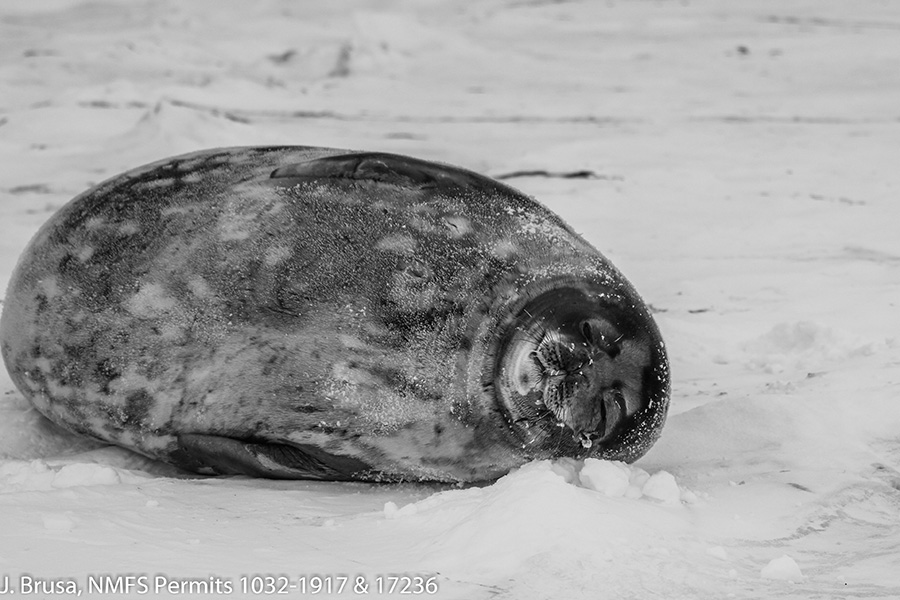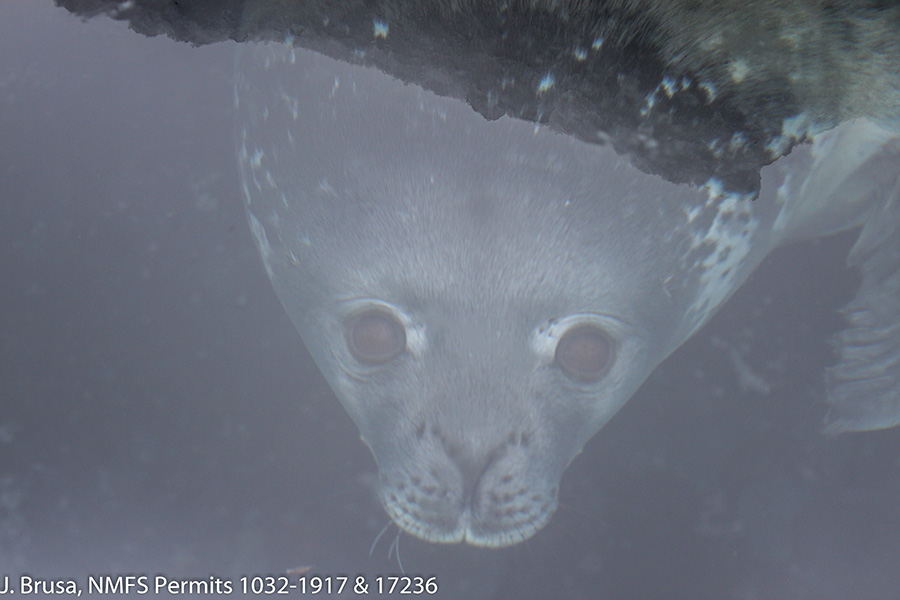Scoping out the seal mating sceneMale Weddell seals tend to have better positions among females the older they getPosted September 20, 2021
Biologists have been observing how male Weddell seals secure prime locations when courting females to learn more about the southernmost mammal's mysterious breeding behavior. In a recent study, scientists followed male Weddell seals over five breeding seasons and found there are some patterns to how males position themselves among females. The researchers found older, more experienced males tend to successfully establish territory around large numbers of breeding females, while younger males just reaching sexual maturity tend to have territories with fewer available females. 
Photo Credit: Jamie Brusa
A male Weddell seal sleeping on the ice in Erebus Bay. Photo taken in accordance with NMFS permits 1032-1917 and 17236.
The reasons for this are unclear, but the researchers suspect it could be that older males are better at fighting for and defending territory than their younger comrades. The preliminary results are helping biologists better understand male Weddell seal survival and how the seal population changes as a whole over time. "It's really useful to know what's going on with this population," said Jamie Brusa, an ecologist at the University of Washington and lead author of the study. "When we learn about where the seals are more likely to be found at certain parts of the year, then if there is some kind of disturbance – natural or otherwise – to part of that habitat, we have a better idea of what kind of impact that might have." Location, location, locationScientists have been studying Weddell seals around Antarctica's Ross Island for over half a century. They've explored how Weddell seal pups survive the harsh cold, how seal mothers raise their young, and even how the animals use sound to communicate. But most of this research has focused on females because they spend more time out of the water than their male counterparts, making females easier to study. Scientists have long been intrigued by mating rituals in pinnipeds (seals, walruses and sea lions) because they usually involve aggressive and brutal contests between males. But Weddell seals breed and fight underwater, so it's difficult for scientists to study the interactions. But during breeding season – late September to early December of each year – males establish territories around groups of receptive females resting on the ice. The males fervently defend their territories and especially holes in the ice where females dive into the water to forage for food. This strategy allows them to monopolize large groups of females and, in turn, the territory they choose determines how many chances they have to mate. In theory, the more reproductive-age females in the territory, the better shot the male has at producing offspring. So, like in real estate, location is everything. Brusa started observing male Weddell seals in Erebus Bay while she was a graduate student at Montana State University. She and her colleagues followed males in the area over five breeding seasons, from 2014 to 2018. They wanted to see if there were any patterns in how males choose locations among breeding colonies, and in particular, if a male's age has anything to do with where he sets up territory. Age is critical to understanding the Weddell seal population because male survival tends to drop off after they hit reproductive age and biologists are unsure why. "Males peak in their survival rate early, about three years of age, right when they're becoming sexually mature, and then their survival rates start to drop immediately," Brusa said. "It was a very exploratory study, kind of a first stab at seeing what might be happening with male reproduction and could that possibly affect their survival rates." Age means something, but not everythingBrusa and her team found there are certain ‘prime' spots where breeding females prefer to hang out on the ice, which are often protected areas good for nursing pups. They also observed older males establish territories around these more ‘prime' locations. Males between 11 and 19 years old tended to hang out in areas with larger groups of breeding females, while younger males tended to have territories with fewer females in areas less suited for nursing pups. 
Photo Credit: Jamie Brusa
A male Weddell seal in the water near a breathing hole in Erebus Bay. Photo taken in accordance with NMFS permits 1032-1917 and 17236.
The researchers can't say for sure why older males tend to get the more coveted territories, but Brusa suspects it could be that younger seals just aren't experienced enough to win contests with other males. "Maybe there's just a prime location that you want to be in, and maybe when you're younger, you're not good enough to be there," she said. "And as you get older, you kind of climb through the ranks and that's where all these receptive females are." It could also be that older males are just more tenacious when it comes to fighting because they have fewer reproductive seasons ahead of them – what biologists call the terminal investment hypothesis. It's unclear how conscious the animals are of their actions, but many species tend to demonstrate greater reproductive effort as they age, according to Brusa. "As a seal gets older, it's going to try harder to reproduce because it could be its last time," she said. "Its chance of surviving to the next reproductive season gets lower and lower." However, the researchers saw a lot of variability in the places where seals of similar maturity established territory, so Brusa suspects age isn't the only factor at play. It could be that some males are just better at fighting for and defending territory, no matter their age. The results, though preliminary, could be used as a benchmark for studying other seal species, especially those that are endangered, like the Hawaiian monk seal. "It's useful to study a really well-protected species to see how things function when they're not in peril and everything should be pretty close to perfect," Brusa said. "We can borrow some information from Weddell seals just to understand some of these life history things as to what we expect monk seals to do." This research is supported by the National Science Foundation, which manages the U.S. Antarctic Program. NSF-funded research in this story: Jay Rotella, Donald Siniff and Robert Garrott, Montana State University, Award No. 1640481. |



For USAP Participants |
For The Public |
For Researchers and EducatorsContact UsU.S. National Science FoundationOffice of Polar Programs Geosciences Directorate 2415 Eisenhower Avenue, Suite W7100 Alexandria, VA 22314 Sign up for the NSF Office of Polar Programs newsletter and events. Feedback Form |


